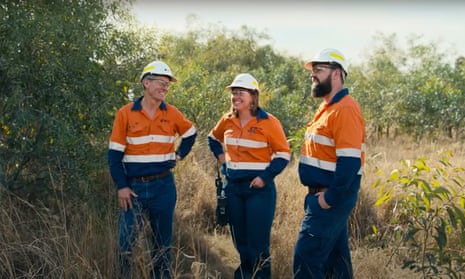“Because in New South Wales, we mine responsibly. For today and tomorrow,” comes the proud declaration at the end of an ad from the state’s mining lobby.
The advertisement from the NSW Minerals Council, seen on streaming services including SBS, features four people wearing the logos of the majority Chinese-owned company Yancoal.
The ad’s focus is on rehabilitation of mining sites and shows areas regenerated after mining “for bushland and cattle grazing”, with cows mooching through long grass.
But it’s hard to go past a claim of responsible mining “for today and tomorrow” from a company that mines nothing other than coal.
According to company reports, Yancoal sold 34.2m tonnes of coal from its NSW mines last year. The company does not disclose what the emissions are likely to be from burning all that coal.
But what of the company’s plans for the future? Does it plan to get out of coal to help the world avoid the worst of the climate crisis?
According to a Yancoal company factsheet, the short answer is no.
“Yancoal is committed to the Australian coal industry, and mining coal will remain our core focus in the foreseeable future,” the factsheet says.
“Over coming decades, we believe our coal will continue to play a key role in delivering economic growth and improved quality of life, especially in Asia.”
Yancoal says its “long-term business priorities” are to strengthen its relationships with customers “throughout the key thermal and coking coal markets”.
An email to Yancoal with questions did not get a response.
Low-emissions coal?
The ad asks viewers to visit a minerals council website that promotes mining rehabilitation and tells how the industry is helping supply “metals and minerals like copper, gold, silver and zinc” for electronics and cobalt for batteries.
Despite the fact that NSW is also responsible for mining 42% of all the coal produced in Australia (second behind Queensland), the fossil fuel gets only a passing reference and, when it does, it’s highly dubious. The campaign says the state produces “high-quality low-emissions coal for energy and making steel”.
But, despite what lobbyists may say, there is no such thing as “low-emissions coal”.
Some coal may produce marginally fewer emissions when processed and burned compared with other coal, depending on its energy and ash content. But when compared with renewable energy or nuclear, coal is a long way from being “low emissions”.
Mine rehabilitation
“There are teams like us all over New South Wales,” one of the four workers portrayed in the ad says. “Restoring the land being used for mining.”
While it’s clearly a positive that mining companies carry out extensive and no doubt expensive repair work in areas they have dug up, they don’t only do this out of the goodness of their hearts.
after newsletter promotion
Rehabilitation works are a legal requirement in the state and are regulated under the state’s Mining Act and overseen by the independent Resources Regulator. Before work starts, companies need a rehabilitation plan in place.
Five years ago the state’s audit office criticised the outcomes outlined in mining plans as being “vague” – an issue that had been acknowledged by the government.
Since then the government has introduced new standards for “clear, achievable and enforceable requirements for rehabilitation”.
Dr Gavin Mudd, an independent sustainable mining expert and environmental engineer, said the industry “is certainly trying to maximise perception or understanding of what they’re currently doing”.
He said: “Many communities all over NSW are not happy with the extent of rehabilitation being completed, especially since most mines are still operating, as well as concerns about the long-term success of rehabilitation.
“The success of rehabilitation remains unresolved and deep concerns remain.”
Georgina Woods, head of research and investigations at the campaign group Lock the Gate, said all mines were required “by law to rehabilitate the land they mine to be ‘safe, stable and non-polluting’”.
“The industry has been made to improve its performance on rehabilitation in particular over the last five years in response to an overhaul by the Resources Regulator of how rehabilitation is planned, managed and reported,” she said.
The NSW Minerals Council said the advertising was “part of the industry’s ongoing efforts to educate the community about the benefits of mining” and to “reassure the public that teams of people at mines all over NSW are working to restore land used for mining.”
The statement said there were “a range of different opinions about coal mining, and people are entitled to their views”.
“However, it is clear that strong ongoing demand for high quality NSW coal will continue to mean jobs and economic benefits for regional communities and the NSW economy.
“At the same time, our world-class miners will continue to employ mining practices, including simultaneous ongoing mine rehabilitation, to ensure the extraction of coal is done responsibly now and into the future.”

